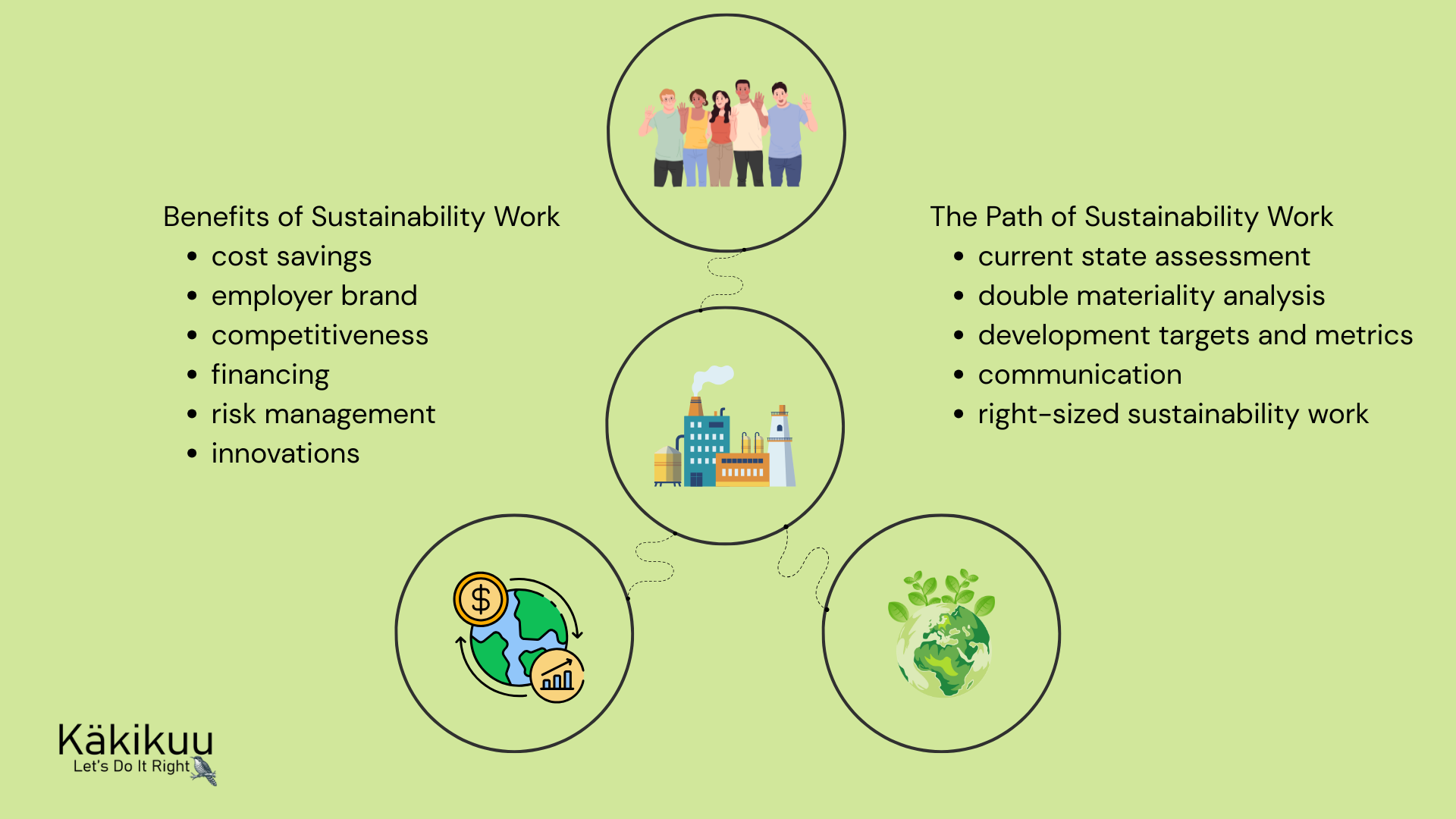The Corporate Sustainability Reporting Directive (CSRD) and its associated double materiality analysis have introduced new requirements and opportunities for companies' sustainability efforts. While the directive primarily applies to large companies, SMEs can also benefit from applying its principles. This article examines what double materiality analysis is and what it practically means for SMEs that are not subject to the directive's regulations.
–
What is double materiality analysis?
Double materiality analysis assesses the impact of a company’s sustainability actions from both the company’s financial performance perspective and the perspective of its stakeholders. This means that the company looks at both the financial significance of sustainability actions (financial materiality) and their impact on people and the environment (impact materiality).
In the assessment of financial materiality, the focus is on how sustainability actions affect the company’s financial position, cash flow, access to financing, and cost of capital. This perspective helps the company identify which sustainability factors could significantly impact its financial performance.
In the assessment of impact materiality, the positive and negative effects of a company’s sustainability actions on people and the environment are examined. This may include environmental impacts, social impacts, and aspects related to the company’s governance. This perspective helps the company identify which sustainability issues are significant from the stakeholders' point of view and how the company can reduce negative impacts and increase positive ones.
–
Double Materiality Analysis in SMEs
Although small and medium-sized enterprises (SMEs) are not subject to CSRD regulations, they can benefit significantly from applying double materiality analysis. The analysis helps SMEs identify key sustainability themes that could impact their business and stakeholders.
For SMEs, stakeholder engagement is a key part of sustainability efforts. Stakeholders can include the company’s employees, customers, partners, financiers, and local communities. Active interaction with stakeholders helps the company understand their expectations and needs, allowing the business to develop in a way that better meets these expectations.
–
Steps of Double Materiality Analysis
1. Identifying and Engaging Stakeholders
The first step in double materiality analysis is identifying and engaging stakeholders. This can be done through stakeholder surveys, interviews, and workshops to gather information on stakeholders' expectations and concerns.
2. Impact Assessment
Next, the company assesses the impact of its sustainability actions from both the financial and impact materiality perspectives. This may include evaluating environmental impacts, analyzing social effects, and identifying risks and opportunities related to the company's governance practices.
3. Action Planning
Based on the assessment, the company can plan actions to improve its sustainability efforts and reduce negative impacts. This could involve, for example, adopting more environmentally friendly production methods, improving employee well-being, or increasing collaboration with local communities.
4. Reporting and Communication
The final step is reporting and communicating sustainability actions. While SMEs are not obligated to report in the same way as large companies, transparent communication of sustainability efforts can enhance stakeholder trust and engagement.
–
Defining Materiality
Defining materiality is a key part of the double materiality analysis. The company must decide which sustainability issues are material and which are not. This decision is based on several factors, such as the environmental impact of sustainability issues, stakeholder expectations, the company’s strategic goals, and the requirements of the operating environment.
The company’s strategy also guides the definition of materiality. The company must examine which sustainability issues align with its business objectives and can contribute to achieving those goals. This may include, for example, developing environmentally friendly production methods or implementing programs that promote employee well-being.
The company’s strategy also guides the definition of materiality.
Impact analysis is an essential part of defining materiality. The company must assess which sustainability issues may cause significant positive or negative effects on the business, stakeholders, and the environment. This analysis helps the company prioritize actions with the greatest impact.
In assessing materiality, a materiality matrix can be used as a helpful tool. The matrix helps visualize which sustainability issues are important from both the business and stakeholder perspectives. It divides sustainability issues into four quadrants based on their significance from these viewpoints.
–
Practical Benefits of Double Materiality Analysis for SMEs
Double materiality analysis helps SMEs develop their business to be more responsible and sustainable. This can enhance the company’s competitiveness and attractiveness in the eyes of stakeholders.
The analysis also helps identify business-related risks and opportunities. For example, managing environmental risks can reduce costs and improve the company’s reputation.
Active stakeholder engagement and transparent communication of sustainability efforts can improve the company's relationships with stakeholders and increase their commitment to the company’s activities. This can lead to better collaboration and new business opportunities.
–
In conclusion
Although the CSRD Directive does not directly apply to SMEs, applying double materiality analysis can bring significant benefits to smaller businesses as well. The analysis helps companies identify the essential impacts of their sustainability efforts and develop their business to be more sustainable and responsible. Active stakeholder engagement and collaboration are key elements in successful double materiality analysis and sustainability work.




0 Comments